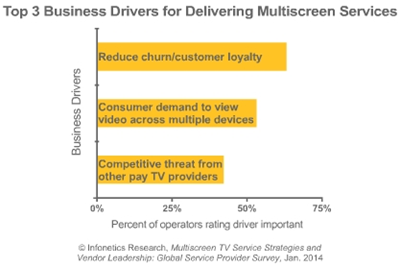 アナリストノート
Infonetics Researchでブロードバンド アクセスと有料テレビを担当する主席アナリスト、Jeff Heynen氏は次のように指摘する。「市場が増大する中、有料テレビ事業者は自らが岐路に立っていることに気付いています。通信会社のIPTV事業者、ネット配信動画 (OTT) 事業者、そして家電企業 - Netflix、LOVEFiLM、Amazon、Hulu、Apple、Samsungなど - に収益の流れが変わり続けており、有料テレビ事業者の従来のビジネスモデルは攻撃にさらされているのです。」
アナリストノート
Infonetics Researchでブロードバンド アクセスと有料テレビを担当する主席アナリスト、Jeff Heynen氏は次のように指摘する。「市場が増大する中、有料テレビ事業者は自らが岐路に立っていることに気付いています。通信会社のIPTV事業者、ネット配信動画 (OTT) 事業者、そして家電企業 - Netflix、LOVEFiLM、Amazon、Hulu、Apple、Samsungなど - に収益の流れが変わり続けており、有料テレビ事業者の従来のビジネスモデルは攻撃にさらされているのです。」Heynen氏はこうつけ加える。「有料テレビ事業者は、コンテンツをいつでもどこでも観たいという加入者たちの希望をどのようにして叶えるかという問題に同時に取り組んでいます。最終的な結果として大きな変化が見られるのは、ビデオコンテンツの取り込み、エンコード、コード変換、再生のためにどの機器に投資するか、また、複数フォーマットでコンテンツを流通させる権利を巡ってコンテンツ所有者とどのように交渉するかという面です。」 マルチスクリーン テレビ調査のハイライト
- セカンドスクリーン アプリと発展型DVR機能のような付加価値サービスは、リビングルームの中にスマートフォン、タブレット、ネット接続テレビが集合したことがきっかけとなって普及した。
- ほとんどの有料テレビ事業者にとって、タブレットが事実上のセカンドスクリーンで、回答事業者の47%が現在マルチスクリーン サービスの一環としてタブレットをサポートしており、2015年までに89%に増加する見込み。
- AppleのHTTPライブストリーミング (HLS) が回答者の使用しているビデオストリーミング プロトコルで現在トップである一方で、Microsoftのスムーズストリーミングは2015年までに終了する。
- 回答事業者の中では、Ciscoがマルチスクリーン映像機器の中で最も馴染みのあるベンダーであり、さまざまな基準で最も高いランクに付けている。
- マルチスクリーンは多くの有料テレビ事業者にとってまだ比較的新しいサービス提供であり、そのためマルチスクリーン機器ベンダーにとっては、自社製品の信頼性を実証し、顧客へのサポートを提供することが必須となっている。
Pay-TV operators look to 'second screen' apps and enhanced DVR in tug-of-war for subscribers Campbell, CALIFORNIA, February 12, 2014-Market research firm Infonetics Research released excerpts from its latest Multiscreen TV Service Strategies and Vendor Leadership: Global Service Provider Survey, which provides insights into pay-TV operators' plans for multiscreen video services and delivering live and file-based video content to subscribers with multiple devices. ANALYST NOTE "In a growing number of markets, pay TV providers find themselves at a crossroads," notes Jeff Heynen, principal analyst for broadband access and pay TV at Infonetics Research. "Their traditional business models are under attack as telco IPTV providers, over-the-top (OTT) providers, and consumer electronics companies - Netflix, LOVEFiLM, Amazon, Hulu, Apple, Samsung, and others - continue to divert revenue away from them."
"Pay TV operators are simultaneously grappling with how to address the desire among subscribers to take their content with them wherever they go, whenever they go," adds Heynen. "The net result is a major change in what equipment pay TV operators invest in to ingest, encode, transcode, and play out video content, as well as how they negotiate with content owners for the right to distribute content across multiple formats. MULTISCREEN TV SURVEY HIGHLIGHTS
- Value-added services like second screen apps and enhanced DVR capabilities have gained in popularity due to the convergence happening in the living room between smartphones, tablets, and connected TVs
- For most pay-TV providers, the tablet has become the de facto second screen: 47% of respondent operators support tablets as part of their multiscreen service now, growing to 89% by 2015
- Apple's HTTP Live Streaming (HLS) currently leads video streaming protocols in use by respondents; however, Microsoft's Smooth Streaming closes in by 2015
- Among operator respondents, Cisco is the most familiar vendor of multiscreen video equipment and receives the highest rankings for a variety of criteria
- Multiscreen is still a relatively new service offering for many pay-TV operators, making it necessary for multiscreen equipment vendors to demonstrate the reliability of their products and provide support to customers

